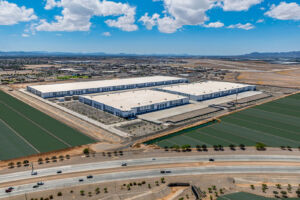Maricopa County continues to be one of the fastest growing in the country, with U.S. Census Bureau reporting that Maricopa was the fourth largest-gaining county in 2023 after taking the top spot in 2022. As more people call Greater Phoenix home, the region’s healthcare sector has needed to grow to meet the needs of patients. According to a Colliers report, the Phoenix medical office market sector continues to expand with 297,714 square feet under construction after posting six consecutive quarters of positive net absorption. Direct vacancy dropped to 11.8% at the end of 2023, compared to the overall office market’s direct vacancy rate of 14.9%.
“Medical office is seeing some really good numbers,” explains Bettina Hunt, senior vice president of healthcare services at Colliers. “Demand has risen, and we know that because occupancy is going up and our rents are up.”
Kelly Carlon, vice president at Avison Young, adds that the market is tight, especially around the major hospitals. Around the HonorHealth Scottsdale Osborn location, Carlon says that she recently put together a letter of intent for a condo near the hospital for $420 per square foot. She compares that to eight years ago, when she recalls similar products going for $250 per square foot. A JLL report states that average overall asking rents increased 5.2% year-over-year.
LEARN MORE: How Greater Phoenix is nurturing a blossoming biomedical ecosystem
“We’re very high on price, which you would expect the high interest rates to help bring down, but we’re doing a lot of deals cash,” Carlon continues. “All the people who need to finance deals are getting pushed out.”
Another factor responsible for this market dynamic is that the supply is generally more constrained than traditional office.
“Medical properties are niche products with specific designs and regulatory compliances. Our tenants have specific needs that once they build the space out and move in, they tend to stay for a long time,” explains Mari Lederman, senior vice president at JLL. “That really cuts down the supply in our sector.”
Strong Medical Office Submarkets
Greater Phoenix is a vast region that covers about 14,600 square miles, which means its hospital system has developed differently than in places such as New York City or Chicago. Lederman notes that historically, healthcare systems in the Valley generally stuck to certain subregions — HonorHealth covered Scottsdale, Banner Health was in the Downtown Phoenix area and the West Valley had Abrazo. Today, those same systems are buying land across Greater Phoenix, which is driving competition and consolidation.
“Individual doctors aren’t hanging out a shingle anymore,” Lederman continues. “Hospital systems and private equity are buying up practices, and individual physicians are joining together in larger practice groups. That means they need more space, and they want to be everywhere in the Valley.”
Carlon adds that many of the larger practices she works with will occupy office space less than 5,000 square feet but have multiple locations near hospitals throughout the Valley.
“What we’re seeing is more but smaller deals all over the place,” she says. “We don’t have just one massive medical center right next to a particular hospital anymore.”
That said, there are submarkets throughout Greater Phoenix that are attracting more development than others. Hunt notes that the Southwest Valley has performed best and has the least vacancies.
“There’s room to grow [in the Southwest Valley] and a lot of people look at the I-10 area, even all the way up to Laveen,” she continues. “We still have a lot of development happening in Goodyear around the City of Hope [Cancer Center]. There is land around there where medical office buildings are starting to get built. The demand [in the submarket] is there but there’s not much inventory yet, but it’s coming online.”
As cities in the Southwest Valley continue to grow, so too with the need for more medical facilities. In Buckeye, Banner Health is building a four-story, 330,000-square-foot hospital with 120 beds with the capacity to grow to 300 beds in the future. Abrazo Health is also bringing a 27-acre Buckeye campus with medical offices, ambulatory services and an acute care hospital. Phase one of that project includes a three-story, 60,000-square-foot medical office building.
On the other edge of the Valley, Carlon says that the practices are looking at Queen Creek, and even further south into Casa Grande.
“Inventory is tight out there in Queen Creek. There’s a lot of new development going on, but it’s just dirt — there’s not a lot of built product,” she continues. “We are looking at dirt for some users, but they don’t always understand what it takes to build. Usually it doesn’t work out, so they end up leasing from someone else. Ground up construction for medical is costly, so we’re doing a lot of office conversions right now.”
Converting Office
With the general office market struggling to recover in a post-pandemic world, converting empty offices into other products is a popular talking point. In Hunt’s opinion, that’s all it is — talk.
“To be honest, I hear more about [conversions] than I see the activity,” she says. “When you start factoring in the cost of what it will take for that conversions and what your rental rates will be, it’s not going to pencil out.”
In Carlon’s experience, she does see conversions happening since inventory is light, even if the process is costly. It’s becoming common enough that she has started bringing contractors on tours of offices so they can assess what work needs to be done to make the space usable as a medical office.
“Savvy medical practices are even bringing an equipment [representative] on tour so they can tell us, ‘We’re going to have to blast through this cement wall to fit this machine in here, then we’re going to lead-base the room to make it work,’” Carlon continues. “Most of the time [tenant improvements] double the cost of the building. It might be a $1 million build out on a $500,000 small medical office.”
Finding the right office to convert can be a challenge, but Carlon says the area around St. Joseph’s Hospital is a prime contender since there are a lot of older office products.
“Some of these buildings went up in the ‘70s and ‘80s need to be converted or changed because we don’t need office space down there anymore, we need medical space near the hospital,” she says. “Medical providers are pretty good at converting these offices now, and they know there’s value in building them out.”
Near HonorHealth Deer Valley Medical Center, an old Cox Communications call center was converted into Blackhawk Medical Center, offering more than 252,000 square feet across three buildings. The project is visible from the Loop 101 and is a single-story, which Lederman says is convenient for patients.
“People can get their imaging done there, go to the clinic, see their doctor, have physical therapy, all in one place,” Lederman explains.
The visibility from the freeway and proximity to a hospital going through and expansion is a key factor of why the property was good candidate for medical office, and its prior use as a call center made the conversion an easier task. Lederman says other factors, such as parking ratios and zoning, must be considered when looking at potential conversions.
“Replacing office tenants with medical tenants really does increase the property income, because it’s a higher rent, and the value of the building because investors like medical,” Lederman concludes. “Blackhawk Medical Center is a great success story.”




